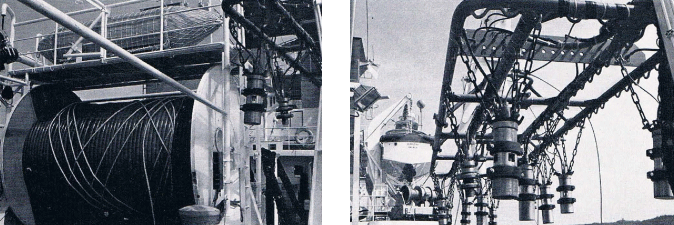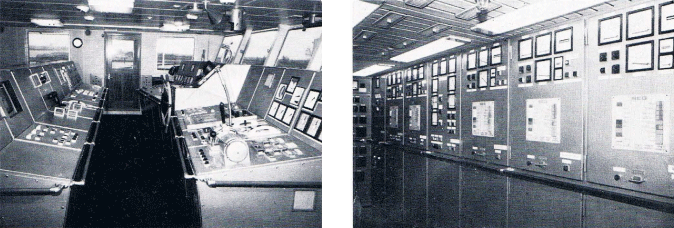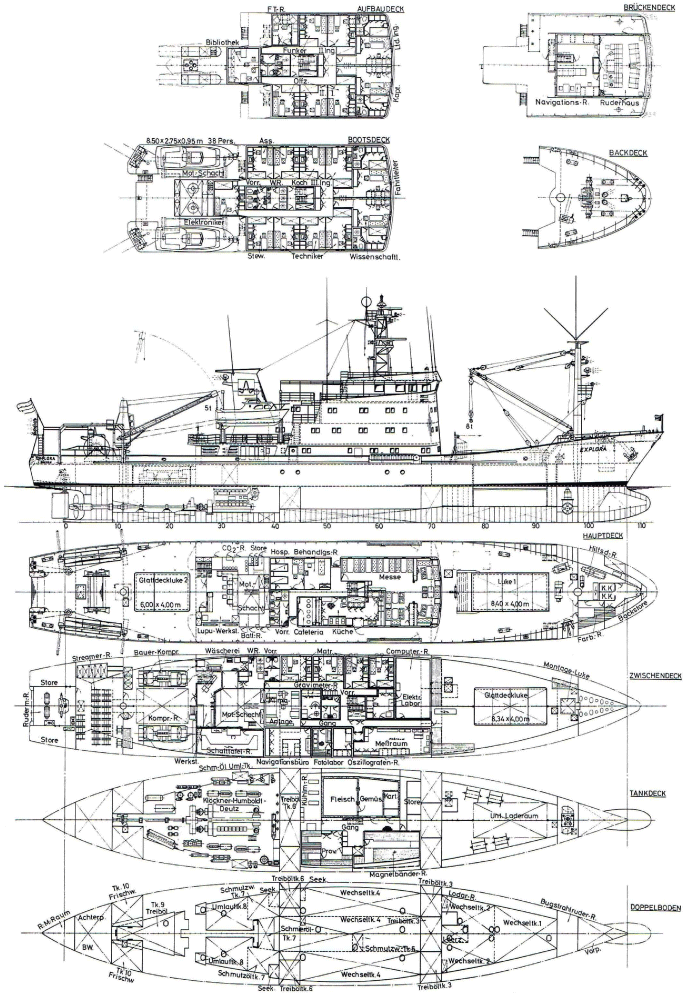Bildbericht von der Gästefahrt, die wichtigsten technischen Daten
Bei herrlichem Wetter fand am 3. Mai 1973 von Kiel aus eine Fahrt unseres zweiten Meßschiffes " EXPLORA" mit 88 geladenen Gästen statt. Als erstes konnten diese die sehr gediegene Einrichtung und technische Ausstattung des Schiffes bewundern. Wenn man bedenkt, zu welch imponierendem Stand sich die Seeseismik aus einfachsten Anfängen in nur zwanzig Jahren entwickelt hat, ist diese Bewunderung für die Leistung der zuständigen Techniker und Wissenschaftler verständlich.
Während der Fahrt von Kiel zum Zielhafen Travemünde wurde ein etwa 10 km langes Testprofil vermessen und wir glaubten dabei auf einem Geisterschiff zu sein. Alles, aber auch wirklich alles, geschieht vollautomatisch. Die Roboter - sprich Computer - bedienen die seismische Apparatur; sie starten das Magnetband, sie lösen alle 10 Sekunden den "Pop" aus, was im Meßraum so klingt als ob jemand mit einer Riesenfaust an das Schiff klopft, sie halten das Magnetband wieder an bis die Luftpulserbatterien neu "geladen" sind, sie starten das Magnetband von neuem, . . . usw. usw. Außerdem halten sie das Schiff mit einer Meßfahrt-Geschwindigkeit von 6 kn genau auf dem gewünschten Meßkurs . . . und es geschehen automatisch noch viele andere Dinge, die für einen exakten Meßablauf erforderlich sind. Die Bedienungsmannschaft tut im Gegensatz zu früher nur dann etwas, wenn es gilt, einen Fehler zu beheben, ansonsten beschränkt sie sich auf die Beaufsichtigung der Apparaturen.
Bevor wir - der Vollständigkeit halber -auf einige wichtige technische Daten des Schiffes eingehen, müssen wir auf eine technische Neuerung hinweisen, die den Besuchern besonders auffiel: Das Schiff hat zwei Rettungs bzw. Verkehrs-Boote, die vollmotorisiert sind und deshalb auch als Vermessungsboote in Flachwassergebieten eingesetzt werden können.
Wir bestiegen über das Fallreep während der Meßfahrt eines dieser Boote, um Aufnahmen von der EXPLORA machen zu können. Wir konnten sehen, daß sogar diese kleinen Boote eine verhältnismäßig umfangreiche nautische Ausrüstung besitzen, zu der u. a. eine Radaranlage, ein Echolot mit Echograph, ein Radarreflektor und eine UKW-Seefunkanlage gehören.
Das linke Bildchen zeigt beide Rettungsboote gleichzeitig, das rechte läßt die Schnelligkeit von über 13 kn ahnen, mit der das Boot - von 125 PS getrieben - durch das Wasser schießt.
RV EXPLORA
An iIIustrated account of an inaugural
trip with guests. Significant technical data.
On a beautiful day on May 3rd, 1973 our second survey vessel "Explora" made a trip from Kiel to Travemünde with 88 invited guests. At first they were able to admire the very solid furnishings and technical equipment of the vessel. If one considers the impressive stage to which marine seismics has developed in only 20 years from its simple beginning, it is no wonder that there is admiration for the work of the technicians and scientists concerned.
An approximately 10 km test-line was surveyed while underway from Kiel to Travemünde, and one nearly imagined to be on a ghost ship. Everything happens automatically. The robots - speak computer - operate the seismic recording equipment, they start the magnetic tape, they initiate a "pop" every 10 seconds which in the ship's mess sounds as if someone bashes against the hull with a gigantic fist, they stop the magnetic tape until the airguns are recharged, they start the magnetic tape once again, etc., etc . . . Moreover, they keep the vessel on the correct course at a survey speed of 6 knots . . . and there are many more things required for an exact survey progress which happen fully automatically. The operators on board only do something, in contrast to previous practice, when there is a breakdown to be repaired. Normally, they check only the instruments.
Before we move on to a description of some important technical details of the vessel we would like to mention a technical novelty which particularly struck the' guests: the vessel has two life-boats or rather they are work-boats as they are fully motorized and can be used as survey boats in shallow water.
During the test survey I boarded one of these boats via the rope-Iadder to take some snapshots of the Explora. I could see that even these small boats have a comparatively comprehensive nautical equipment among which are a radar set, a recording echo-sounder, aradar reflector, and a VHF marine radiotelephone set.
The left picture shows both tl:le life-boats, the right one gives a hint of the 13 knots speed with which the boat, driven by 125 horsepowers, rushes through the water.
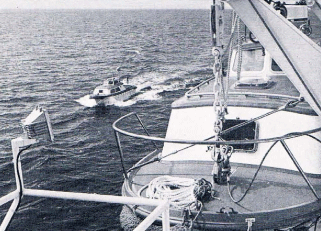
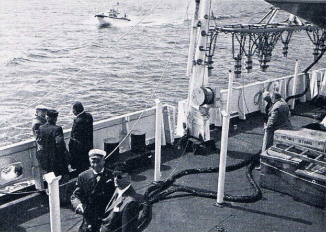
In drei vorhergehenden PRAKLA-SEISMOS-Reports haben wir bereits, zum Teil recht ausführlich, den Werdegang dieses modernen Meßschiffes beschrieben. Wir beschränken uns hier deshalb nur auf die allerwichtigsten Daten:
In three previous Issues of the PRAKLA-SEISMOS Report we already described in some detail the progress of this modern survey vessel. We limit ourselves here, therefore, to the most important data:

